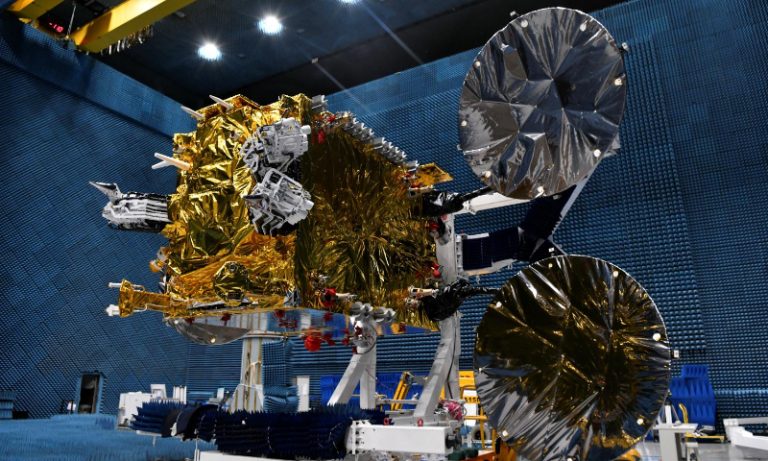Delivering Payloads to Mars with CHAMPS: The Future of Space Transport
The CHAMPS initiative proposes using commercial sub‑kilowatt Hall‑effect thrusters on small spacecraft, launched as secondary payloads via NASA’s CLPS program, to perform lunar gravity assists and deliver scientific payloads into Martian orbit more frequently and at lower cost than traditional missions.
Summary
- NASA’s “Moon to Mars” program targets crewed missions by the late 2030s, driving development of advanced propulsion and life‑support technologies.
- The Commercial Hall Propulsion for Mars Payload Services (CHAMPS) concept was introduced at LPSC 2025 by Gabriel F. Benavides, Steven R. Oleson, and Alain S.J. Khayat. (LPSC PDF)
- CHAMPS uses Northrop Grumman’s NGHT‑1X thruster, based on NASA’s H71M design, to propel ≤500 kg spacecraft.
- Missions would launch as secondary payloads under NASA’s CLPS initiative, conduct a lunar gravity assist in near‑rectilinear halo orbit, then cruise to Mars.
- A three‑month low‑thrust spiral, four‑month coast, and seven‑month braking sequence inserts the spacecraft into low Mars orbit.
- Scientific instruments include a Visible/UV imager (like MARCI), a thermal infrared radiometer (mini‑MCS), and a near‑infrared spectrometer (Argus‑style).
- The orbiter will map Martian weather patterns, measure atmospheric composition, study dust and ice clouds, and relay data for surface missions.
- After two years, the craft ascends to a areosynchronous orbit for continuous atmospheric monitoring.
- CHAMPS aligns with NASA’s Mars Exploration Program Initiative 1 for frequent, low‑cost science missions.
- Commercial partnerships aim to mature the H71M thruster under the Small Spacecraft Electric Propulsion project.

Introduction
NASA’s “Moon to Mars” program aims to land humans on Mars by the end of the 2030s, necessitating breakthroughs in propulsion, life support, and resource utilization. To enable low‑cost, flexible robotic missions, NASA researchers have unveiled CHAMPS: the Commercial Hall Propulsion for Mars Payload Services concept.
Technology Background
Electric propulsion, particularly Hall‑effect thrusters, uses electric fields to accelerate ionized propellant, offering high specific impulse and efficient use of xenon gas. NASA’s H71M sub‑kilowatt thruster, developed under the Small Spacecraft Electric Propulsion (SSEP) project, can process over 30 % of a small spacecraft’s initial mass in propellant over 15,000 operating hours. Northrop Grumman’s NGHT‑1X system is a commercial derivative of the H71M.
CHAMPS Mission Concept
CHAMPS missions would hitch a ride as secondary payloads on lunar deliveries under NASA’s Commercial Lunar Payload Services (CLPS) initiative. After release, the spacecraft inserts into a near‑rectilinear halo orbit (NRHO) around the Moon and performs a gravity assist maneuver once a favorable Earth‑Mars alignment occurs. The propulsion profile involves a three‑month spiral departure from NRHO, a four‑month coast phase, and a seven‑month low‑thrust insertion into Martian orbit.
Table 1: CHAMPS Mission Timeline
| Phase | Duration | Description |
|---|---|---|
| Lunar Assist | ~2 months | NRHO gravity assist from near‑rectilinear halo orbit |
| Low‑Thrust Spiral | 3 months | Continuous thrust to gain trans‑Mars trajectory |
| Cruise Phase | 4 months | Coasting on heliocentric transfer |
| Mars Orbit Insertion | 7 months | Thrusted braking and orbit capture |
Spacecraft and Propulsion
Each CHAMPS spacecraft is designed to be ≤500 kg, powered by fold‑out solar arrays supplying sub‑kilowatt electrical power to its NGHT‑1X thruster. The thruster’s magnetic shielding prolongs its lifetime by reducing channel erosion, enabling extended missions.
Instruments & Science Objectives
The payload includes:
| Instrument | Role | Heritage Reference |
|---|---|---|
| Visible/UV Imager (MARCI‑style) | Daily global weather imaging at 5 visible and 2 UV bands msss.com | MARCI |
| Thermal IR Radiometer (mini‑MCS) | Profiling atmospheric temperature and dust distributions | Mini‑MCS concept |
| NIR Spectrometer (Argus‑style) | Measuring water vapor, ozone, and aerosols in the atmosphere | Argus instrument |
“Establish a regular cadence of science‑driven, lower‑cost mission opportunities as a new element of the MEP portfolio to provide rapid and flexible response to discoveries.” — NASA Mars Exploration Program Initiative 1 Phys.org
These instruments will map Martian weather patterns, study seasonal dust storms, and monitor volatile transport between the surface and atmosphere. Plasma sensors will characterize Mars’ space weather environment.
Future Prospects
By leveraging commercial propulsion and launch services, CHAMPS could enable annual or biennial Mars missions, expanding participation across academia and industry. Reusable small spacecraft may carry diverse payloads, from atmospheric probes to data relay satellites.
Facts
- NASA’s H71M thruster can operate for more than 15,000 hours, processing hundreds of kilograms of xenon propellant.
- The NGHT‑1X thruster on Northrop Grumman’s Mission Extension Pods uses the same core design as H71M.
- MARCI produces a daily global weather report of Mars in seven color bands.
References
- LPSC 2025 CHAMPS Paper
- Delivering Payloads to Mars with CHAMPS – Phys.org
- NASA H71M Propulsion Technology
- Northrop Grumman NGHT‑1X Thruster
- NASA CLPS Initiative
- NASA Mars Exploration Program Plan
- MARCI Instrument Description
- Mini‑MCS Radiometer Concept
- Argus NIR Spectrometer Patent
- Northrop Grumman DS‑72 HALO PDF
- ESA Gateway PPE Image
- NASA TOPS Patent – LEW‑TOPS‑34
- SIMPLEx Program Overview
- USRA SmallSat 2018 Study
- NASA GRC Compass Lab





